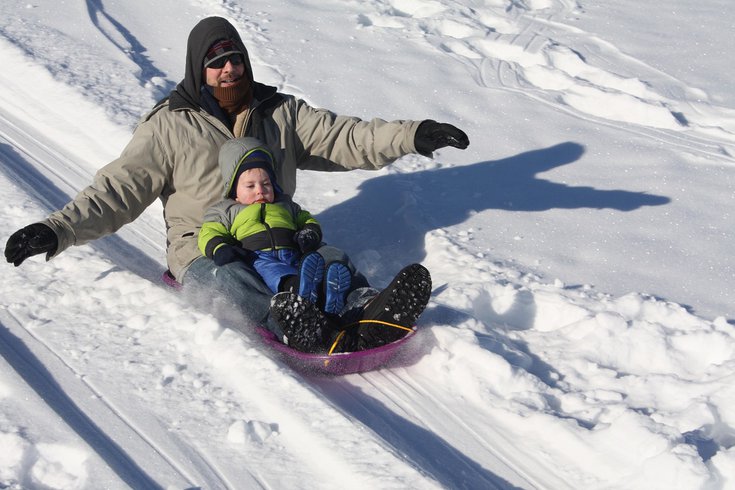
January 25, 2022
 Darren Mehl/Pixabay
Darren Mehl/Pixabay
More than 20,000 children and adolescents are treated for sledding injuries every year, research has shown. Pediatricians stress the need for kids to wear helmets.
Sledding seems like an innocent childhood activity, but it can quickly turn dangerous.
More than 20,000 children and adolescents are treated for sledding injuries every year, research has shown. Head injuries are the biggest risk when children fall out of sleds, or sleds collide with a tree or another sledder, pediatricians say.
A study published last November in the Clinical Journal of Sports Medicine found more than 220,000 people were treated in U.S. emergency departments for sledding-related injuries between 2008 and 2017. And almost 70% of these patients were age 19 or younger.
Fractures were the most common injury among children and adults, but children were more likely to sustain head injuries and be diagnosed with concussions, a type of closed-head injury.
In a closed-head injury, the brain is injured by rapid shaking inside the skull. It can cause damage to brain tissue and blood vessels. These injuries most commonly occur during collisions.
Skull fractures can cause dangerous pressure on the brain and may require surgical intervention.
Though sledding-related injuries decreased over the study period, the researchers emphasized the importance of wearing helmets to reduce the severity of head injuries, a practice that few parents enforce.
Yet, the American Academy of Pediatrics, American Association of Orthopaedic Surgeons and Safe Kids Worldwide recommend helmets for sledders. The U.S. Consumer Product Safety Commissions advises the use of ski, bicycle or skateboard helmets.
Children's Hospital of Philadelphia offers helmets and other safety gear through its Safety Center, stressing the importance of wearing sport-specific and properly fitting helmets while doing winter sports, including sledding.
Pediatricians at Intermountain Primary Children's Hospital in Salt Lake City, Utah reported seeing twice as serious sledding injuries last year as they did the previous winter – with some of them requiring specialized intensive care. None of the children sent to the emergency department were wearing helmets when the sledding accidents occurred.
Dr. Jeffrey Upperman, surgeon in chief at Monroe Carell Jr. Children's Hospital in Nashville, Tennessee, made a plea to parents earlier this month during an interview with WTVF.
"I think if you're going to put your kid on a sled, go ahead and dust off that bike helmet and put them on a sled feet first with their bike helmet on," Upperman said.
Despite these recommendations and warnings, many parents don't require their kids wear one. According to a new poll of nearly 2,000 parents, many just don't see sledding as dangerous.
The poll, conducted by C.S. Mott Children's National Hospital in Michigan, showed that children almost always wear helmets while downhill skiing or snowboarding, but they are less likely to do so when sledding.
Seventy-three percent of the parents polled said their children always wear a helmet when downhill skiing or snowboarding. Another 12% said their children sometimes wears a helmet when doing those activities. In addition, 83% said their children always wear a helmet on a snowmobile.
However, 70% said their children never wears a helmet when sledding – despite sledding being the most common activity they expect their children to do in the winter. And only 1 in 6 parents are likely to talk to their children about sledding safety rules.
"Because sledding is so common, parents may overlook important safety concerns," said Sarah Clark, the poll's co-director. "However, to avoid injuries, parents should ensure the sledding area is free of trees or other objects and has a flat runoff area at the bottom of the hill. Parents should also make sure children understand strategies to avoid collisions with other sledders."
Here are eight sledding safety tips:
• Purchasing sleds that have a steering mechanism and brakes – allowing for better control.
• Make sure all equipment is in good condition with no dangerous edges or malfunctions.
• Check sledding hills to make sure they are spacious enough and without a lot of trees and other objects that sledders could strike.
• Choose a hill that has a level run-off at the bottom so sleds can safely stop.
• Avoid hills that end near a street or parking lot.
• Do not let children sled on, or near, frozen lakes, streams or ponds.
• Teach children to sit on sleds or lay on their backs with their feet pointing downhill. They should never sled head first.
Parental supervision is important when young children are doing outdoor winter activities, Clark emphasized. Parents should use their judgement on whether older children also require adult supervision or will follow safety measures on their own.
She added that if adult supervision is not a possible, children should have a cell phone with them for emergencies and a parent should be close enough to respond quickly to an injury or another emergency.